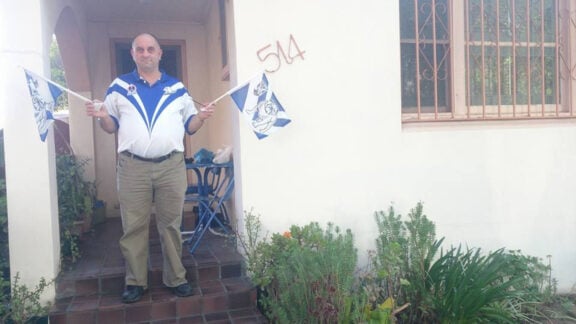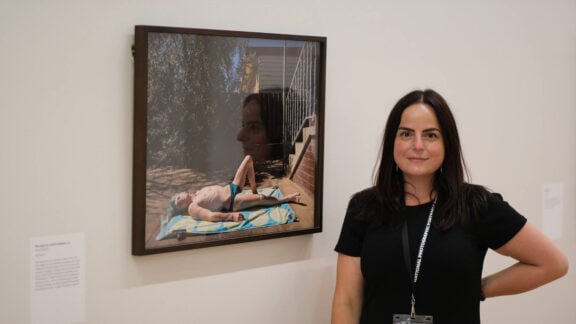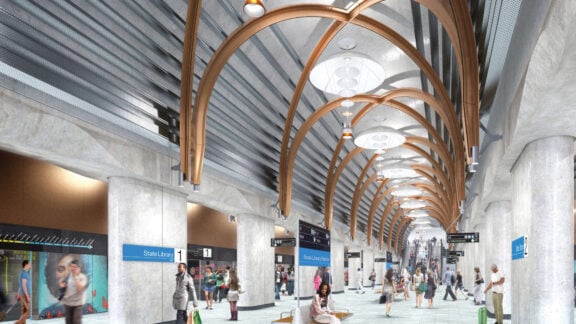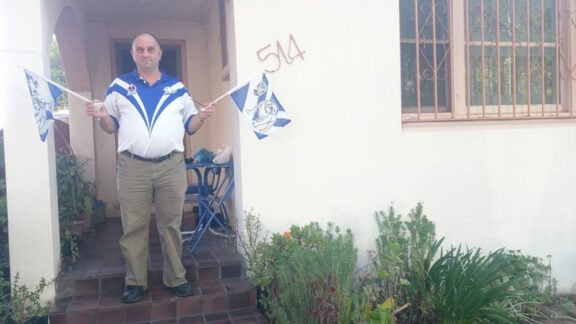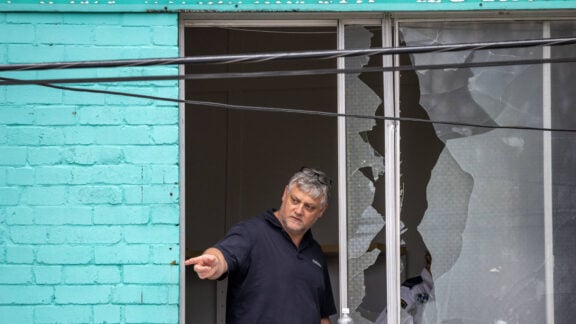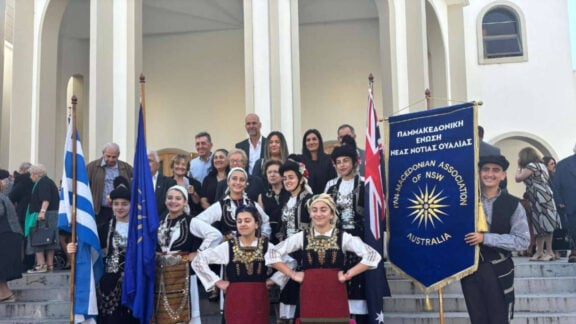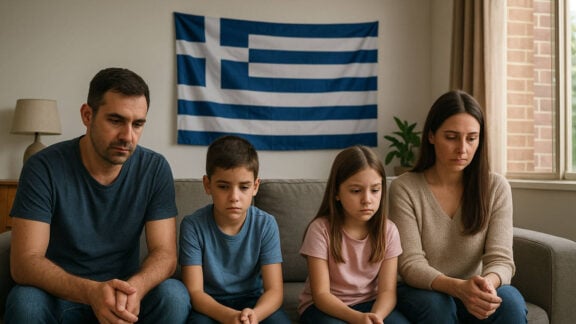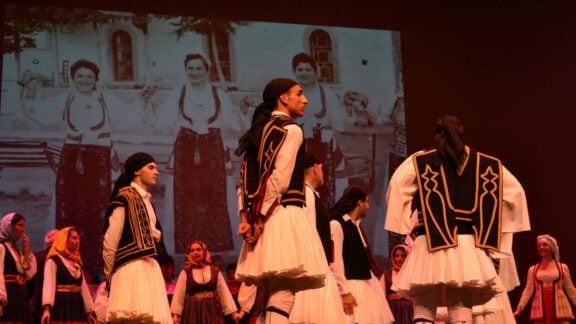Steve (Skevos) Tsoukalas is a man of the arts. Not in the conventional denotation of the term, but that doesn’t really change anything; Steve is an artist, still.
From 1968 to this date, he had been working at the most emblematic ‘temple of the arts’ in the country. His job was not directly related to the arts but was art nonetheless. For 50 years, every single morning at 5.30 am Steve would commence his artwork.
Before the doors of the Sydney Opera House would open to receive its esteemed guests, Steve, using the craft of his art, a sponge and a secret olive oil and alcohol-based solution, would ‘paint’ the shine on every metallic and decorative surface in the building. Sometimes, he would employ a bicarbonate soda concoction he had come up with, which, as he said “was gentle to the hard surfaces in the building, gets rid of the traces of fumes”; he would liven up even the brick walls.
Most people called him a conservator, a rather conventional description of Steve Tsoukalas’ work. For those hearing him talk about his relationship with “the old majestic lady” as he loved to call the Opera House, it was clear that every time he laid his hands on her, she would feel better.
At the start of the year, Steve made a life-changing decision, to end his professional relationship with the “old majestic lady” to dedicate more of his time to the other ladies in his life, his three granddaughters and his “angel”, his wife Marina. It was a huge decision.
“My daily reality for 50 years was not a regular day-to-day. Never in 50 years did I groan on my way to work, I had no stress. I would go to work and it didn’t feel like going to work. I would always go in a good mood as if I was going home,” Steve says.
The ‘guardian’ and his ‘castle’
“We shape our buildings; thereafter they shape us,” Winston Churchill once said, and it is this ascertainment of his on the interaction between men and buildings that encapsulates most accurately Steve’s quinquagenarian work reality.
Steve left Kalymnos island to arrive in Australia in 1964 at the age of 19. He was the youngest boy in a family of 10; four of his older brothers had already immigrated Down Under and settled in Sydney. They received him with open arms.
“To me, it did not quite feel like migrating to a foreign country. It was not as heavy, as I had my brothers taking care of me, I found a home waiting for me. I did not struggle like other immigrants have. Finding a job was easy, but learning the language was not, it was hard for me to learn. Regardless of what type of work you do, you need the language.”
He received his baptism of fire – like many other migrants did – at a factory. Not long after, he realised it was not the right job for him and started working in construction.
“From there I ended up a labourer in the jungle, in Western Australia. We were building bridges. Another tough job. The conditions we worked under were not humane, which is why I decided to return to Sydney.”

Steve and his “angels”
Steve returned to Sydney in 1968. It was the year that changed his life forever.
“That’s when I got the Opera job. When it was being built. That same year I met my angel and we got married.”
Soon after his two sons came.
“Circumstances change when people marry. The responsibilities are different. You need to grow your family, cater for them and build for your children.”
And that’s exactly what Steve did day in, day out, hovering somewhere between the ground and the sky on the Sydney Opera House scaffolding. That is when their special relationship began, a creative relationship, yet one of life and death. Every time he’d place a tile on its roof he’d risk his life. The “old majestic lady” would not only demand his respect but also all of his five senses in a constant state of alertness.
“They started building the Opera in 1958 but its construction was ongoing until long after its grand opening in October 1973. Nearly a year went by after 1973 till its completion, but the building already required restorative work and renovations,” he added, explaining how he went from being a seasonal builder to become the Opera House’s permanent guardian.
Close to 1,600 people were employed during the Opera House construction phase but only 20 were required for its maintenance post-completion and Steve was amongst those “lucky ones”.
“Some say it was luck. It wasn’t my luck that kept me close to her, it was my hard work,” he says, once again referring to the building as if it is a living entity.
“Management liked me for my tireless work ethic and devotion to the building. I would not miss one day of work. They treated me like a person, not as a number. I had learned the language, the way migrants did at the time; my English was simple. Taking it step-by-step with my basic English skills, my love for the job, the interactions with the staff, the architects, the mechanics, the managers, it all helped. It gave me courage; I did not care about how I’d pronounce words. They did not treat or see me as an immigrant, they did not look down on me. They all extended the warmest embrace and enveloped me. I loved the management and through them, the building.”
This is how Steve’s love for the Sydney Opera House grew; through the respect and appreciation its people showed him. The warmth he received from his supervisors entered the building’s soulless corners, soaked its materials and transformed it into a living organism, developing the need in Steve’s heart to take care of it as one takes care of their loved ones.
“It is a building that represents this country, a symbol known across the globe. When people look at the Opera they automatically think of Australia. I felt proud for being part of this family and I will feel proud for as long as I live.”
Every year, eight million people visit the Sydney Opera House, and in his 50 years of serving it Steve encountered many – perhaps too many –famous, non-famous, weird, happy, sad, young and old people. His fondest memory, though is of Telly Savalas.
“I was moved by Aristotle Savalas. ‘So, this beautiful building is soaked in Hellenic sweat?!’ he said in broken Greek when I saw him and went to shake his hand and introduce myself. I’ll never forget these words.”
The ‘other’ reality
Steve Tsoukalas is a man with endless resources of kindness and affection.
“My relationship with the Opera will never end. She’s in my thoughts, she’s hanging on my home’s walls. She’s everywhere,” he says.
It’s harder to imagine that his farewell to the “the old majestic lady” will be final, than to envision him roam her corridors once again to share with her his new life experiences away from her. However, it will be a while until they meet again as for the immediate future, Marina, Vissaria, and Katerina will be monopolising his time. His day-to-day belongs to them and he is more ready and willing than ever to be immersed in their presence and make the most of every minute with them he can afford.
“When a man starts walking towards the twilight of his life, he often begins to philosophise. When you reach 73 and have grandchildren you have to philosophise. So, I think it’ll be good for me to become a child again with them. To bring back my childhood memories. To relive life without worry. To kick the ball in the park with them,” he muses.
“They’d spend each night waiting for me to come home from work and play with them. I can’t bear it in my heart to leave them waiting any longer.”

